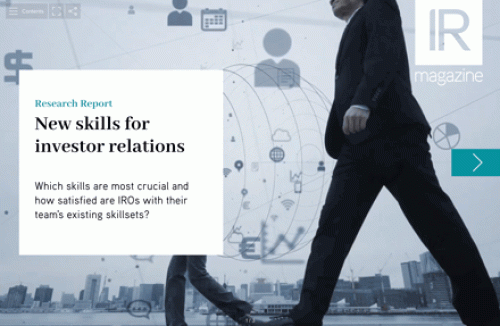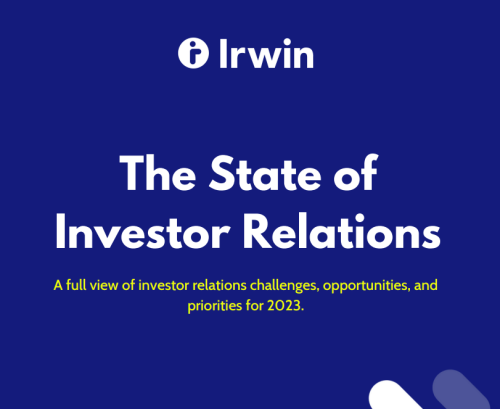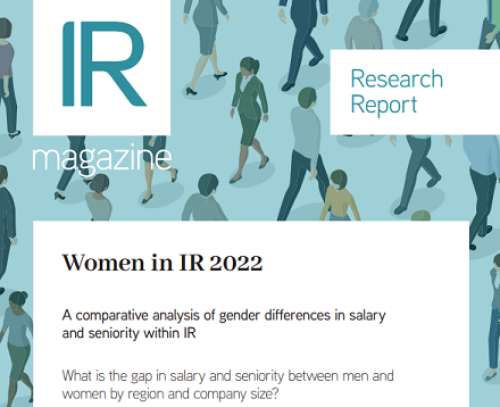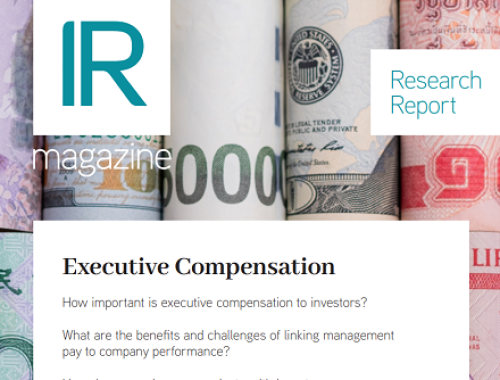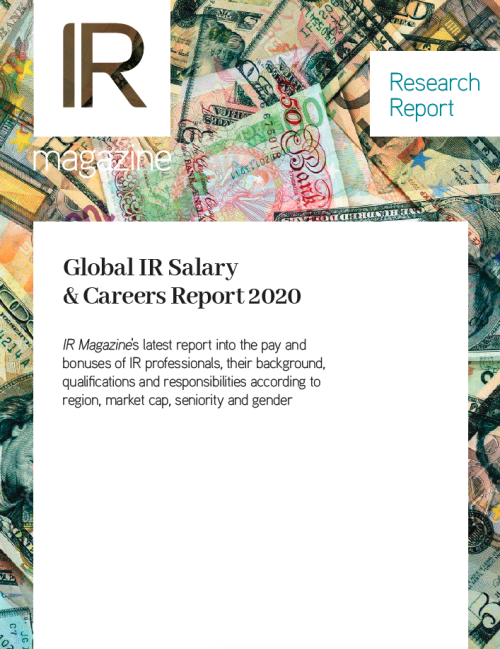Elizabeth Judd explores the pay gap revealed by IR Magazine‘s global survey of IR practices
IR has never been men’s work. From the earliest days of the profession, women have shone, with female names too numerous to count gracing the lists of IR legends. But when it comes to salary, things get complicated fast.
Several studies show the infamous wage gap between men and women exists in IR as surely as in other professions.
According to the IR Magazine Global Practice Report 2012, 75 percent of male heads of IR earn more than $150,000, but only 68 percent of female heads of IR can say the same.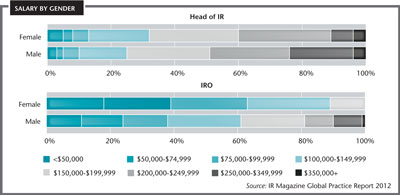
Click to enlarge
Moreover, nearly a quarter (24 percent) of male IR heads earn more than $250,000 a year, compared with just one in eight female IR heads (13 percent). The analysis is based on data from 445 respondents.
At the lower end of the scale, the disparity is even greater. For IROs (IR managers or less senior members of the IR team), two thirds of males (62 percent) but only one third of females (37 percent) take home more than $100,000 a year. And a male IRO is nearly four times more likely to earn in excess of $150,000 than a female counterpart.
CIRI turned up similarly dispiriting results. According to the association’s 2012 Investor Relations Compensation and Responsibilities Survey, male IROs, on average, received total cash compensation of C$215,000 ($219,000) in 2011, while females earned an average of C$157,000.
This 27 percent gender gap is in line with 2008, but narrower than earlier years. What’s more, CIRI found that only 8 percent of female IROs received $300,000 or more in compensation, compared with 23 percent of men.
Almost everyone evinced surprise over the numbers, with a few questioning their validity. For some women, however, gender is clearly an elephant in the room, its presence unmentioned yet keenly felt.
Many women in IR roles have adapted to the fact that they spend most of their time operating in the male-dominated sphere of finance and investing.  ‘I find it’s a man’s world in investor relations because of who you’re dealing with on a day-to-day basis and who’s your boss,’ explains Jennifer McCaughey, senior director of IR and financial communications at Transcontinental in Montreal.
‘I find it’s a man’s world in investor relations because of who you’re dealing with on a day-to-day basis and who’s your boss,’ explains Jennifer McCaughey, senior director of IR and financial communications at Transcontinental in Montreal.
‘Who are the CEO and CFO inside your company? They’re typically men. I went on a roadshow to western Canada in October and, in all the meetings we had, I saw only two women. Moreover, the 10 sell-side analysts who cover us are all male.
‘I’ve learned to be forceful and direct, but I’ve seen young women in my profession get emotional on occasion. You can’t do that. You need backbone and thick skin. You have to be able to take it – or you’re not going to make it.’
One explanation for the gender pay gap could be higher numbers of men working for larger firms, which typically pay higher salaries, but the IR Magazine Global Practice Report 2012 notes that the average male/female split among IR jobs is 47 percent/53 percent, and this doesn’t alter significantly across any market cap.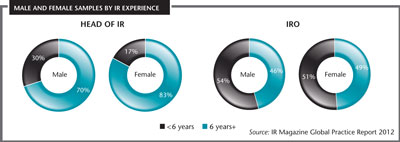
Click to enlarge
When it comes to years of experience – another factor that contributes to compensation – the report actually finds that 83 percent of female IR heads have worked in the field for six or more years, while only 70 percent of male IR heads have done the same. The existence of a pay gap favoring men is consistent across survey respondents in North America, Europe and Asia.
Pay gap? What pay gap?
Although the numbers paint a bleak picture for female IROs, many women have not noticed any pay discrepancy. Ruth Cotter, vice president of IR at AMD, began her IR career in Ireland in the 1990s.
‘At that time, there was a disconnect between what women and men earned,’ she recalls. ‘It appeared that women in Ireland were underpaid.’ Since moving to the US in 1999 and landing higher-level IR jobs, Cotter hasn’t noticed a wage gap.
Heather McGregor, managing director of Taylor Bennett, a London-based search company specializing in communications and IR, and author of Careers advice for ambitious women, says that in her experience ‘there’s absolutely no pay gap’ when it comes to high-level IR jobs.
To illustrate, she says that in a current very senior IR search she’s conducting for a FTSE 50 company, there are three women and three men on the short list, and all three women out-earn the men.
For McGregor, statistics suggesting a wage gap are likely explained by the idiosyncrasies of the profession. ‘There’s no going rate for IR jobs,’ she explains. ‘Every job is bespoke.’ She says a multitude of factors affect IR pay, including the market cap of the employer, the industry and the number of analysts following a company.
Smooch Repovich Reynolds, managing partner of the IR and communications practice at Caldwell Partners in Encino, California, has conducted IR searches for 25 years, and she offers a similar picture:
‘Because there’s no traditional pathway to the IRO role, that skews compensation.’ Reynolds also says compensation numbers are affected by the fact that ‘women take different steps out of their careers than men do – and maternity leave is one of those time periods.’
Gillian Karran-Cumberlege, a partner at Fidelio Partners, a board and executive search firm based in London, is similarly surprised by the idea there might be a gender gap for women at the highest levels of IR. She contrasts IR roles with corporate boards, where the gender demarcations are stark: at FTSE 100 firms today, only 17.3 percent of directors are women.
No equal footing
Outside of IR, signs abound that the compensation gender gap continues to exist. In a 2012 study, the American Association of University Women found that women graduating from college in the US earn just 82 cents for every dollar earned by their male counterparts, says senior researcher Christianne Corbett.
American women at different stages of their careers earn 77 cents to a man’s dollar – a figure that’s improved since the notorious 59 cents of 1960 but still remains far from equal. What’s worse, she notes, progress seems to have stalled over the past 10 years.
Corbett also points out that relatively small discrepancies in pay widen with the years. For young women starting out 18 percent behind young men, with each identical percentage increase, the pay gap grows. ‘It’s rather like compound interest,’ she explains. ‘These little advantages in the workplace accumulate with time.’
Finally, one highly intangible factor – the culture of an organization and of its leadership – may make a critical difference to how women are valued. Lyndsay Wright, director of IR for William Hill, a multi-channel gambling company based in the UK, says she’s never negotiated for higher compensation or a better job title in any of the three companies where she’s been an IRO, and yet she’s steadily moved up. ‘Our CEO is very supportive of women in senior management,’ she explains.
Career management
One possible explanation for pay differentials in investor relations is the backgrounds of the individuals surveyed. The CIRI study, for instance, suggests that more male IROs come out of finance – historically a well-remunerated field – and more females out of communications.
Specifically, CIRI found that 40 percent of male IROs have financial or accounting backgrounds, compared with just 14 percent of women.
Similarly, more men have earned relevant qualifications. CIRI found, for instance, that 21 percent of male IROs have CFAs, compared with just 6 percent of women.
‘We’re seeing more people with a finance background come into the role, and they certainly have more senior titles,’ says Yvette Lokker, president and CEO of CIRI.
Karran-Cumberlege suggests that at least part of the gender pay discrepancy may be explained by the breadth of the role, with an increase in what she dubs ‘IR plus’.
Nowadays, she says, ‘there’s a big up-tick in compensation for IR plus communications or IR plus strategy or corporate affairs. With each of these, you begin to move into another pay bracket.’
Navigating a career path to assume progressively more responsible roles is something men may do more successfully than women. ‘I’ve seen women who can do this tremendously well, but I’ve perhaps seen more men who are proactive about it,’ adds Karran-Cumberlege.
McCaughey is an example of a female IRO who views her career very strategically, positioning herself for greater challenges over time.
She’s spent the past 10 years at Transcontinental, where she advanced from a financial analyst to her current role overseeing all financial communications as well as IR. ‘I find that if you don’t ask, you don’t get. Nothing is given to you on a silver platter,’ she says.
Backing up requests with a solid business case for why you deserve a certain salary is critical. ‘I have stepped back in certain situations because I had to gain the experience necessary to gain the respect,’ says McCaughey.
‘I’ve sometimes accepted a lower salary as a challenge to prove myself in the role. Once I established myself, then I asked for a higher salary. If I know I’m worth something, I’m going to ask for it. The worse that can happen is they’ll say, No.’
McCaughey urges female IROs to manage their careers more proactively. ‘If you stay in the same role too long and you are good at it, the company may just want to keep you there,’ she points out.
‘You don’t want to be pigeonholed. Once I’ve learned the job I’m in, I move on to other challenges. You need to keep yourself marketable.’
Knowledge is power
Corbett and Stephanie Goetsch, a career strategist and founder of Spark Career Strategy in Washington, DC, suggest that many women don’t have the same negotiating savvy as men.
The 2012 Investor Relations Talent Management & Salary Report from UK recruitment specialist EMR offers a glimpse into why this might be the case.
According to the study, 67 percent of females were satisfied with their year-end bonuses, compared with 51 percent of males. ‘Females reported higher levels of satisfaction than males, despite receiving a lower average amount,’ the report notes.
Goetsch observes that almost every man she advises immediately mentions pay as a priority, while few – if any – women do. ‘There’s a fundamental difference in attitude,’ she says. ‘I’m generalizing, but women often say, Thank you! I’m so happy to receive a bonus, while men are scratching and clawing and saying, This isn’t enough.’
Negotiating is key to increasing one’s salary, but women face disadvantages here, too. Corbett points out that studies show women are far less likely to negotiate than men.
‘More than that, though, research shows that women are less likely to get what they want when they do negotiate,’ she says. ‘Women perceived as advocating too aggressively for money aren’t viewed well.’
To get around this, McCaughey recommends doing one’s homework about what others earn inside and outside the company. ‘Information is critical,’ she says.
‘In one job, no one was getting a pay increase and I was getting zero, too. I wasn’t going to make a federal case out of that. In these situations, knowledge really is power.’
Finding the necessary data points isn’t always easy, especially given a cultural taboo against discussing money. ‘We never talk about compensation.
But if nobody wants to talk about it, it’s difficult to get information,’ says Lokker. She recommends reading industry surveys and studying any other data available to determine what salary levels might be attainable.
For instance, CIRI found IR salaries in Canada have recently been rising, with a 9.3 percent increase in 2011 over the previous year.
Next, Reynolds advises creating an actual business case for why you want higher compensation. ‘You’ve got to think critically about the business reasons and why you deserve every increase,’ she says. She urges women to make their wishes clear in a way that might be considered classically masculine.
‘At the lower levels of IR, there may be a pay disparity because women don’t ask for more money,’ says McGregor. ‘But by the time a woman is head of IR, she’s learned to ask for a raise. Ask [your colleagues] outright about salary. Most people are willing to share.’
Perks beyond money
A final reason why male IROs might outstrip female IROs in terms of compensation is values. ‘To me, fair compensation is important, but an appropriate work/life balance and challenges in the workplace matter to me, too,’ says Cotter.
Having started at AMD as a junior IR manager and climbed to the vice-presidential ranks, she notes that working at an organization where she can pick up her children from school when necessary means more than a gargantuan year-end bonus. ‘A lot of it comes down to values and what’s important to the person,’ she emphasizes.
McGregor agrees: ‘Women and men want different things.’ She points out that a woman who heads an IR function may ‘know the job inside out’ and complete everything in 20 percent less time than someone else. But instead of moving to a better-compensated position, ‘she might value having that extra time,’ says McGregor.
Even if some women prioritize professional perks besides money, everyone agrees that the playing field for compensation really ought to be level, especially given that women have contributed tremendously to this profession.
‘Very often there’s an openness to see women in the IR role because they have that blend of skills – technical, relationship-based and communications – necessary to succeed,’ concludes Karran-Cumberlege. ‘There are a lot of women doing a fantastic job in IR.’

